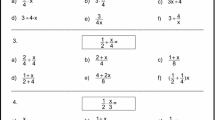Abstract
This study is an empirical investigation of 11th graders at a German high school (Gymnasium). Working over a 24-hour period in a computer lab, we investigated students' use of quadratic functions with `Derive', and trigonometric functions with `Mathplus' (or `Theorist' for Macintosh). We were particularly interested in the working styles of students while they solved problems and looked for changes in these styles, as compared to traditional paper and pencil activities. While students worked on the computer, their activities (such as inputs from the keyboard, menu choices or mouse movements) were saved by a special program, which ran in the `background'. We are interested in the possibilities of developing a research method based on these `computer protocols'. The study should be seen as an exploratory study for developing hypotheses for further empirical investigations.
Similar content being viewed by others
REFERENCES
Demana, F. and Waits, B. K. (1992). College Algebra. A Graphing Approach. Reading: Addison-Wesley.
Dörfler, W. (1993). Computer use and views of the mind. In C. Keitel and K. Ruthven (Eds), Learning from Computers: Mathematics Education and Technology (pp. 159-186). Berlin a.o.: Springer.
Heid, K. (1988). Resequencing skills and concepts in applied calculus using the computer as a tool. Journal for Research in Mathematics Education 19(1): 3-25.
Heid, K. (1996). A technology-intensive functional approach to the emergence of algebraic thinking. In N. Bednarz, C. Kieran and L. Lee (Eds), Approaches to Algebra. Perspectives for Research and Teaching (pp. 239-255). Dordrecht: Kluwer.
Heugl, H., Klinger, W. and Lechner, J. (1996). Mathematikunterricht mit Computeralgebra-Systemen. Bonn: Addison-Wesley.
Hillel, J. (1992). Mathematical Problem Solving and New Information Technologies, NATO ASI Series. Berlin a.o: Springer.
Hirlimann, A. (1996). Computer algebra systems in French secondary schools. The International Derive Journal 3(3): 1-4.
Hofe, V. R. (1998). Probleme mit dem Grenzwert-genetische Begriffsbildung und geistige Hindernisse. Journal für Mathematikdidaktik 19(4): 257-291.
Kieran, C., Boileau, A. and Garançon, M. (1996). Introducing algebra by means of a technology-supported, functional approach. In N. Bednarz, C. Kieran and L. Lee (Eds), Approaches to Algebra, Perspectives for Research and Teaching (pp. 257-293). Dordrecht: Kluwer.
Krummheuer, G. (1993). Orientierungen für eine mathematikdidaktische Forschung zum Computereinsatz im Unterricht. Journal für Mathematikdidaktik 14(1): 59-92.
Mayes, R. (1994). Implications of research on CAS in college algebra. The International Derive Journal 1(2): 21-37.
Mayes, R., Schmidt, L. and Swandon, T. (1996). ACT in Algebra: The function concept. The International Derive Journal 3(2): 17-37.
O'Callaghan, B. R. (1998). Computer-intensive algebra and students’ conceptual knowledge of functions. Journal for Research in Mathematics Education 29(1): 21-40.
Palmiter, J. R. (1991). Effects of computer algebra systems on concept and skill acquisition in calculus. Journal for Research in Mathematics Education 22(2): 151-156.
Pea, R. (1985). Beyond amplification: Using the computer to reorganize mental functioning. Educational Psychologist 20(4): 167-182.
Pierce, CH. S. (1967). Schriften I. Frankfurt: Suhrkamp.
Pierce, CH. S. (1968). Ñber die Klarheit unserer Gedanken. Frankfurt: Suhrkamp.
Repo, S. (1994). Understanding and reflective abstraction: Learning the concept of derivative in the computer environment. The International Derive Journal 1(1): 97-113.
Ruthven, K. (1997). Computer algebra systems (CAS) in advanced-level mathematics, A report to SCAA. School of Education-University of Cambridge.
Schmidt, W. (1984). Mathematikaufgaben-Anwendungen aus der modernen Technik und Arbeitswelt. Stuttgart: Klett.
Smith, K. (1994). Studying different methods of technology integration for teaching problem solving with systems of equation and inequalities and linear programming. Journal of Computers in Mathematics and Science Teaching 13(4): 465-479.
Weigand, H.-G. (1991). Iteration sequences and their representations. Educational Studies in Mathematics 22(5): 411-437.
Weigand, H.-G., Weller, H. (1998). Modelling real-life problems involving periodic processes with computer algebra. International Journal of Computer Algebra in Mathematics Education 5(4): 251-267.
Author information
Authors and Affiliations
Rights and permissions
About this article
Cite this article
Weigand, HG., Weller, H. Changes of Working Styles in a Computer Algebra Environment – The Case of Functions. International Journal of Computers for Mathematical Learning 6, 87–111 (2001). https://doi.org/10.1023/A:1011482007276
Issue Date:
DOI: https://doi.org/10.1023/A:1011482007276




